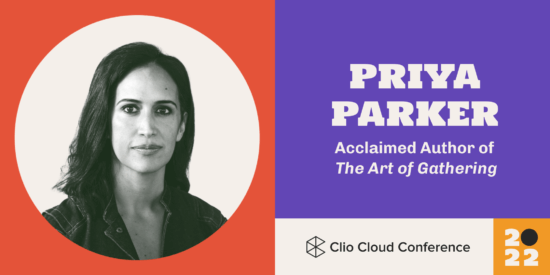Have you ever had a bad meeting at your law firm? One where you didn’t get to the root of the problem, where you didn’t walk away with clear next steps for your legal case, or where things just fell flat?
Most of us spend many hours of our days in meetings, but we’re also only too familiar with the above scenario.
However, Priya Parker is dedicated to making all sorts of gatherings better, work meetings included. A master facilitator, strategic advisor, acclaimed author of The Art of Gathering: How We Meet and Why it Matters, and executive producer and host of the New York Times podcast, Together Apart, Priya facilitated an immersive and memorable experience at the 2022 Clio Cloud Conference that left attendees re-thinking how they gather. Her belief is that when a host has the generosity of spirit to care and to try, any gathering can be meaningful and successful.
“To get people to say something that’s authentic or real, to take a risk, that’s something that can be designed for,” she says. Below, we share a few transformative things to keep in mind based on our conversation with Priya.
Start here to shift meetings at your law firm from meetings that could have been an email to engaged gatherings with a purpose.
In person vs. online meetings
As the pandemic wanes, it’s increasingly clear that we live in a world where hybrid meetings are here to stay. While in-person meetings have their benefits, the 2022 Legal Trends Report found that 25% more clients (35% compared to 28% pre-pandemic) now prefer virtual meetings over in-person meetings—and the rest indicated no strong preference either way.
To meet client expectations and provide a client-centered experience, law firms need to provide the option to meet virtually, or in a hybrid environment (ideally using a solution that integrates with their practice management software). How can they do this well?
For Priya, it’s important to keep in mind that when it comes to in-person versus online, one isn’t intrinsically better than the other. “Whether a meeting is virtual or in-person is putting the cart before the horse,” she says. “Neither is good or bad; it’s what we make of them.” As an example, Priya pointed to the New Yorker comic from March 2020 referring to all the meetings that really could have been emails.
The key, whether online or in-person, is to have a clear purpose and structure for the meeting, and a clear reason why those attending are there. “What is the actual need here? Why are we actually meeting?” Priya suggests asking. “Make sure the people who can actually achieve that purpose are being gathered in ways that are structured and thoughtful and effective.”
Law firm meetings with staff
Client-centered, antifragile law firms need to be aware of different processes and pain points within their firms and along the client journey. Otherwise, they won’t be able to solve these issues and continue improving and innovating.
But, as Priya notes, in professional services organizations like law firms where there’s a traditional hierarchy, information about a client, process, or team can get stuck at lower levels of the hierarchy due to fear, timing, worries about perception, and a number of other issues. For example, “if your purpose is to be incredibly client-driven, and your clients are interfacing with people who aren’t lawyers, you probably have no idea how you’re doing if you’re not hearing from those people,” says Priya.
How can law firms solve this, and have better meetings with staff where key issues and great ideas are surfaced? Priya says it starts with culture. “You don’t fix the meeting. You fix the culture, and then the meetings take care of themselves,” she explains. “If the purpose is just to compete, there’s no gathering where you’ll make people feel included because that’s not the currency of the culture.”
The most successful organizations Priya has seen are the ones where leaders are able to help everyone feel like owners and contributors, so that everyone, including those with more institutional power, are aligned on what the firm’s common purpose is. “When all sides realize that they have a common purpose and they need to work together in order to achieve it, that’s when things come together,” says Priya.
You may like these posts
Meetings with law firm partners
In many professional services firms that Priya works with, including law firms, there’s a partnership model. And with that model, a good amount of decision making about the firm is shared. The stakes are high, and everyone has a lot of power, and a lot of skin in the game. It can be hard to push things through if not everyone in the room is on-board.
“When I work with teams like that, the most important skill to build is consensus building,” says Priya. Getting people to talk about what they actually think, versus tiptoeing around different subjects and opinions, is the key to laying out all the information on the table so partners can come to an agreement. The key is to be direct.
“When we start practicing what we actually think, we start to understand what the real needs are, what the real fears are, and to talk to each other about it. Because a lot of workplaces are inhibited more by unhealthy peace than unhealthy conflict.”
If there are more nodding heads than butting heads in your law firm, that’s not automatically a good thing. Challenge yourself and your partners to bring what you really think to the table so that your team can face challenges head on and grow to new heights.
Meetings with legal clients
Lawyers have a crucial role to play in some of the most important moments in people’s lives. But they might miss out on an opportunity by focusing on the wrong thing.
“I think for better or for worse, lawyers are at the center of incredibly meaningful and sometimes painful life moments. And in a culture that is hungry for ritual, lawyers are often the only individuals that are people in the room at moments of incredible interpersonal and individual transition.” said Priya. “Lawyers are the people who are there to hold the emotional transition of what people are walking through. That’s an incredibly important skill and it’s kind of a sacred act.”
To provide better client experiences, consider the purpose of creating a good experience for clients and helping them reach their goals at every meeting.
Priya recalls an example from The Art of Gathering where The Red Hook Community Justice Center asked “What is the purpose of the justice system we want to see? And what would a court look like if it was built according to that purpose?” The organizers behind the center decided to take a problem-solving approach rather than an adversarial one. They lowered the judge’s bench to be eye level with the defendants and other members of the court. There is a holistic review of the case, looking at substance abuse, mental health issues, trauma, and other factors. And the judge, Judge Calabrese, takes time to get to know the details of each case, and there is a sense he is rooting for the defendants to succeed.
As of 2018, the center had reduced the recidivism rate of adult defendants by 10%, and of juvenile defendants by 20%.
By focusing on those interacting with the justice system and what they needed to succeed, Judge Calabrese and the organizers at Red Hook transformed the legal experience for their entire community. What could your firm do for the client experience if you took a step back to focus on the true purpose of each client meeting?
“When we pause and ask what seems like obvious questions, we get some pretty radical answers,” says Priya.
Final thoughts
When asked what one thing she would change about the way everyone in the world gathers, Priya once again brings it back to purpose. “I’d have them first pause and take a deep breath and ask ‘what is the actual need here, and who within my community or outside it might help me address it?’”
Whether you’re meeting with law firm staff, partners, or clients, having a clear focus, sticking to it, and ensuring the right people are in the room goes a long way towards making any meeting or gathering sing.
We published this blog post in November 2022. Last updated: .
Categorized in: Business









